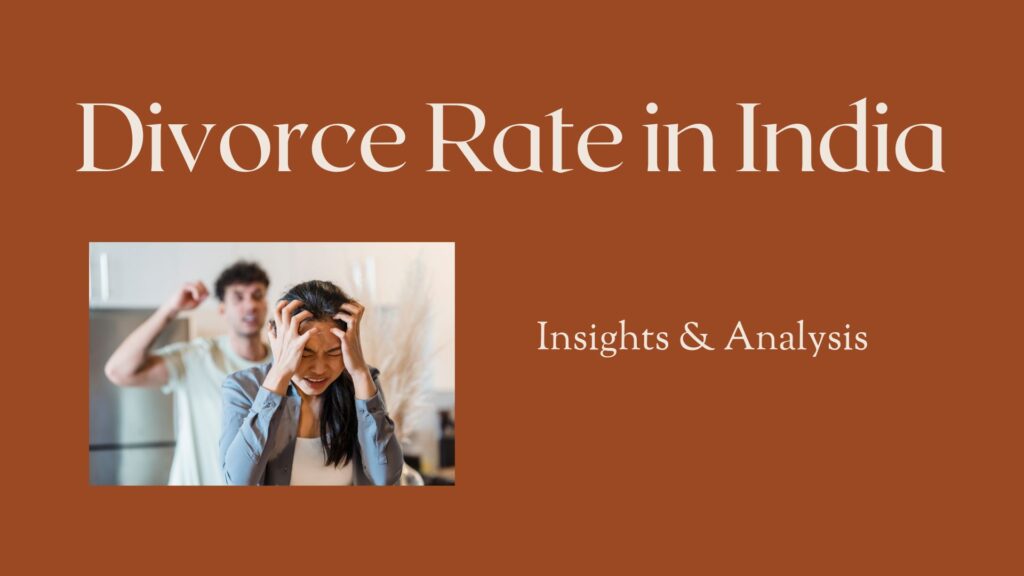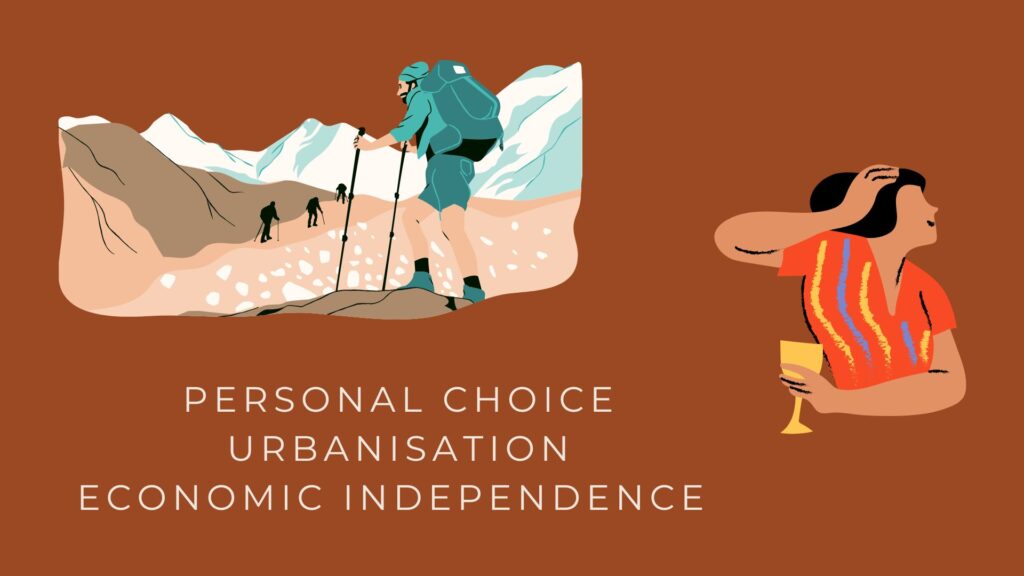
Introduction
Divorce in India, once a rare occurrence, is becoming increasingly common due to important shifts in social and cultural norms, economic independence, and modernisation. The traditional understanding of marriage as a lifelong commitment is being challenged by emerging individual aspirations and urbanisation. The increase in divorce rates reflects greater personal choice and autonomy; it also brings with it a set of challenges, particularly for families and children involved. This blog explores the reasons behind the rising trend of divorce in India and its multi-pronged impact on families.
Divorce has always been seen negatively across societies. Divorce does not just affect the couple splitting up; it impacts society too. Even though the latest statistics show that the divorce rate is dropping slightly, mainly because millennials are marrying later, about half of all marriages still end in divorce. This affects children, family finances, and the workplace. Divorce happens because of complex psychological reasons. When a relationship lacks balance and harmony, it leads to problems that can push people to end their marriage. Directly or indirectly, divorce impacts the mental health of spouses, children, family members, and friends.
Historically, divorce used to involve a strict set of procedures. Infidelity and infertility were the most common reasons for divorce. Some countries, like Italy, Brazil, Argentina, Ireland, and Spain, did not officially allow divorce until the late 20th century. Nowadays, it is easier to get divorced; unhappiness is a valid reason. Other common causes include adultery, domestic violence, lack of emotional support, addictions, and midlife crises. Money issues are a big factor too. Financial stress can reveal underlying problems or make partners feel more isolated. Yet another common complaint is having an overworked spouse. Social pressure plays an equal role. In societies more tolerant of divorce, especially under certain conditions, the divorce rate might be higher than in cultures that are less tolerant.
For example, in 2011, the United States had a divorce rate of 53%. Some European countries are in a similar position, with Belgium having the highest rate at 71%. In contrast, India’s divorce rate was as low as 1% in 2011, reflecting a different cultural attitude towards divorce.
“A recent study shows that divorce rates in India may be near 11%. The lower divorce rates compared to other countries do not mean India has more happy marriages, just that attitudes towards divorce differ.”
Kamal, relationship expert, Rematch
The Evolution of Divorce in Modern Indian Society
Historically, in traditional joint families, marital conflicts were resolved within the family, with elders playing a key role in reconciliation. However, over the last few decades, several factors have contributed to the rising incidence of divorce:
1. Urbanisation and Migration – The movement of people from rural areas to urban centres has led to the weakening of joint family systems, leaving couples to navigate marital issues without the support of extended family members.
2. Women’s Economic Independence – With more women pursuing higher education and careers, financial dependency on spouses has reduced, empowering women to leave unhappy or abusive marriages.
3. Shift from Arranged to Love Marriages – While arranged marriages traditionally dominated Indian society, there is now a greater acceptance of love marriages. However, in love marriages, many couples struggle with the expectations of both partners and their families, leading to discord. This is not limited to love marriages, but the percentages are higher for love marriages in India.

4. Increased Awareness of Legal Rights – Awareness of legal rights and access to legal aid has enabled individuals, especially women, to seek separation in cases of domestic violence, infidelity, and incompatibility.
5. Social Acceptance and Reduced Stigma – While divorce was once heavily stigmatised, changing attitudes have made it more acceptable, especially among younger generations.
“Growing up, divorce was something that I imagined happened mostly in Western countries. I never imagined I would go through a divorce and live with my head held high like I am doing now.”
Induja, trained Bharatanatyam dancer and teacher, mother
6. Technology and Social Media Influence – The rise of social media has contributed to marital dissatisfaction by fostering unrealistic expectations and easy access to extramarital relationships.
“If you look up the posts of X, it is very clear that the younger generation all believe in soulmates and perfect love. They think what they see on their screens is real and possible. Mostly, they are listening to influencers who themselves only have a half-baked idea of how relationships and love work in real life.”
Kamal, relationship expert, Rematch
The Impact of Divorce on Families
The breakdown of a marriage has emotional, psychological, financial, and social consequences for all involved. In India, marriage is seen as a union between two families, and divorce affects more than just the couple. Parents and relatives feel emotional distress, societal embarrassment, and financial burdens associated with supporting their divorced children.
Impact on Children
The impact of the conflicts during a divorce is expressed differently by children. When kids are constantly exposed to conflict, they struggle because they see the world more negatively. This changed perspective can cause relationship issues in future. Many children experience anxiety, depression, and insecurity following their parents’ divorce. A disrupted family environment can lead to decreased academic performance and behavioural problems. Without a positive example of marriage, while growing up, these kids may have relationship and trust issues as adults.
The effects of divorce on each gender are unique. After a divorce, boys tend to act out more, causing trouble at home and school. Girls, however, often react with sadness and become more inward-focused. In a study by Shukla & Rai (2021) all the families agreed that divorce impacted their social life, and a large majority said it affected their employment too.
Due to fewer resources and big changes in family dynamics, children from single-parent families often show riskier behaviour than those from two-parent homes. In cases of contentious divorces, one parent may manipulate the child against the other, leading to strained parent-child relationships. Many of these kids get involved in alcohol, drugs, and sexual experimentation. They are also more likely to be expelled from school, use weapons, and run away from home. These behaviours can lead to teen pregnancy or criminal activity. Extended family members might struggle to stay connected because they feel pressured to take sides. Additionally, certain children suffer when they are moved from one home to another.
“Most of my friends ask me if it is weird having two families and homes. I actually enjoy having two places to call home and that my parents are happy.”
Manisha, 18-year-old, parents separated when she was a tween, Mysuru
Manisha’s parents decided to stay in the city and shared joint custody – allowing her to stay with her father on the weekends and her mother on weekdays. Manisha’s case and her parents’ mature handling of the family dynamics, however, are an exception.
Impact on the Couple
Even though both partners are financially worse off after a divorce, women’s finances and living standards are more affected than men’s in general. Women, particularly those from traditional backgrounds, face significant challenges post-divorce. Many women, especially homemakers, find it difficult to sustain themselves financially after divorce. Despite changing attitudes, divorced women face societal judgment, making remarriage difficult. Raising children alone can be challenging both emotionally and financially.
While divorce brings financial challenges for women, men also experience difficulties. Men are less likely to seek emotional support from friends and family, leading to loneliness and depression. Alimony and child support obligations can create a financial strain on them. Fathers struggle to obtain custody or sufficient visitation rights to maintain strong bonds with their children in certain cases.
Additionally, divorce can have negative effects on the workplace. Research shows that about one in ten employees divorce or split up every year. Divorce can increase presenteeism, absenteeism, anxiety, stress, and other health problems among workers.
Coping Strategies and Solutions
While divorce is sometimes inevitable, it is essential to address its impact and offer support to affected individuals and families. Educating couples about realistic expectations and conflict resolution can help prevent marital breakdowns.
“Certain communities insist on pre-marital counselling, which is something that should be made mandatory for all. For example, the Catholic communities in south India have a 3-day pre-marriage counselling session that couples attend before the wedding.”
Kamal, relationship expert, rematch
Professional counselling can help couples address issues before resorting to divorce. Strengthening legal frameworks and providing financial support to single parents will ease the transition post-divorce. Reducing the stigma around divorce and promoting gender equality will create a more supportive environment for affected individuals. In addition, providing guidance to divorced parents on co-parenting can ensure children receive adequate emotional and financial support.
Conclusion
The divorce rate in India signifies a shift in socio-cultural dynamics, reflecting greater personal freedom but also posing new challenges for families. While divorce can provide relief from toxic relationships, it is important to acknowledge its impact and work towards minimising its negative effects. By promoting awareness and encouraging healthy relationship dynamics, societies could bring about positive changes in the landscape of marriage and family life in India.
To read more about the divorce act and trends and statistics related to divorce, read our blogs on the same.
Are you looking for ideal matches or better romantic connections? Download the Rematch app to find great matches and long-term relationships with people that align with your life goals and interests.
References
Shukla, Komal, and Bhagwat Singh Rai. “Evaluation of Divorce Rate and Its Impact on the Society of Burhanpur District of Madhya Pradesh.” Ilkogretim Online – Elementary Education Online 20, no. 1 (2021): 6513–6518.
SL Legal Services. “Why Are Divorces Becoming More Common in India?” SL Legal Services, August 2024. Accessed February 7, 2025. https://sllegalservices.com/why-are-divorces-becoming-more-common-in-india/.
Vincent, Pinto, and Laveena D’Mello. “Changing Trends of Divorce in India: Issues & Concerns.” International Journal of Management, Technology, and Social Sciences (IJMTS) 3, no. 2 (December 2018).

